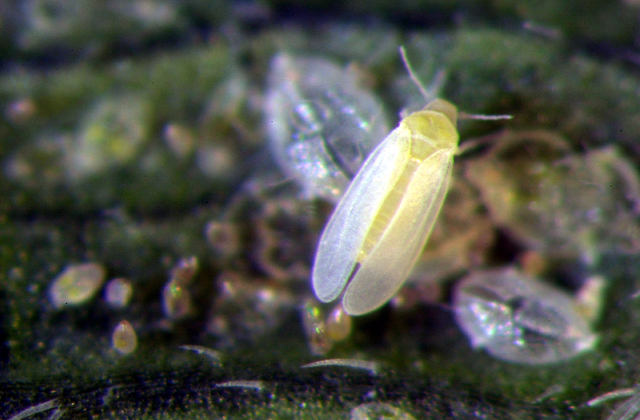Researchers Continue to Keep Close Tabs on Whitefly
 For many growers, the end of summer means it’s time to think about poinsettias. By now, growers are likely deep in the throes of production, hoping to keep cuttings free of pests and diseases through to December.
For many growers, the end of summer means it’s time to think about poinsettias. By now, growers are likely deep in the throes of production, hoping to keep cuttings free of pests and diseases through to December.
Poinsettias are plagued by a whole host of insect pests, from spider mites at the growing points all the way down to fungus gnats at their roots. For many growers, whitefly is enemy number one, with good reason.
Three main whiteflies exist in both greenhouse and nursery production: sweet potato whitefly (Bemisia tabaci), greenhouse whitefly (Trialeurodes vaporarorium), and banded winged whitefly (T. abutiloneus). The three types share characteristics, such as:
• They feed on plant sap, or phloem
• They lay eggs on the undersides of leaves
• Their life cycle can be as quick as three weeks if conditions are favorable
• They have no dormant stage and cannot tolerate freezing temperatures
• They have a very wide host range.
Though they share some commonalities, some key differences exist. Sweet potato whitefly is the one that raises most concerns because it has distinct, biologically different biotypes, biotype B (also called MEAM1) and biotype Q (also called MED).
Biotype B can be controlled using regular methods and even some biologicals. Fortunately, B is the most common biotype in the U.S. Biotype Q, on the other hand, is resistant to many classes of insecticides, such as some insect growth regulators, pyrethroids, and neonicotinoids.
Dr. Lance Osborne of the University of Florida, and Dr. Cindy McKenzie of USDA’s Agricultural Research Service (ARS), are evaluating insecticide efficacy and the impact of product rotations on whitefly biotype populations. For example, some combinations of insecticides encourage a population shift from one mixed with both B and Q to one that is solely Q. This demonstrates Q’s tolerance of insecticides.
“All whiteflies are difficult to control, whether they are biotype B or Q,” Osborne says. “When you are dealing with poinsettia or hibiscus and have a mixed population of the two biotypes, our studies show that most pesticides push the populations to Q biotypes. That being said, the populations are still manageable with the tools we have.”
Control of biotype Q isn’t necessarily more difficult than B, but may require different products. Some of Osborne and McKenzie’s latest research indicates the following, newer insecticides are effective against biotype Q.
• Acetamiprid (TriStar , foliar)
• Cyantraniliprole (Mainspring, soil drench)
• Dinotefuran (Safari, soil drench)
• Flupyradifone (Altus , foliar and/or soil drench)
• Pyrifluquinazon (Rycar, foliar)
• Spinetoram + sulfloxaflor (XXpire, foliar)
This research was partially funded through the Floriculture and Nursery Research Initiative. AmericanHort and the Horticultural Research Institute do not endorse any specific products. Please consult product labels before using.
Resistance Management is Essential
“We’ve been lucky over the last few years to get some new compounds that are effective for Q control, but we need to be diligent in our resistance management programs to preserve their utility,” Osborne says.
On the other hand, products such as bifenthrin, pyriproxyfen, acephate, pymetrozine, and others have reportedly failed to control Q, but still control B in many sites. Biological controls can be effective against whitefly if they are applied preventively. They can help you stay ahead of whiteflies, but do not provide the needed quick knockdown of large populations.
The clear benefit of knowing which biotype is present is being able to better select the proper control measures. Some growers have opted to bypass the step of biotyping and rely on using only those products that are effective against both biotype B and Q. While effective, they reported significantly greater costs in their chemical programs as a result. Making the effort to find out which biotype is present can save growers money and reduce the number of spray applications (through the use of biologicals).
So, how do you know? Most importantly, B cannot be differentiated from Q without molecular tools. Fortunately, biotyping is a free service provided through FNRI funding, administered by USDA-ARS.
Why Should we Care as an Industry?
Biotype B is widely distributed throughout the U.S. in greenhouse, outdoor vegetable, and cotton production. Until last year, Biotype Q was only known to exist in greenhouse production — not in outdoor agriculture. That changed in 2016 when several outdoor, landscape sites in Palm Beach County, FL, tested positive for a Q infestation. Other sites in Florida were identified as well.
This is alarming, as biotype Q would be especially problematic in vegetable and cotton production in southern regions. Q’s insecticide resistance would severely burden those industries, potentially limiting food and fiber supplies. Not surprisingly, the vegetable and cotton industries are carefully monitoring these new developments. State regulators are as well. USDA has responded with the reinstatement of the whitefly biotype Q task force (acronym WTF-Q) with the goal of bringing together folks from industry, research, and regulatory units to address the concerns. AmericanHort and HRI participate on the task force, representing the green industry.
Many growers in our industry are paying attention.
“Biotyping whiteflies is a very important management tool in growers’ toolboxes,” says Ben Bolusky, Chief Executive Officer of the Florida Nursery Growers and Landscape Association. “You don’t want to be lulled into believing you’re controlling one biotype of whitefly when it’s really the other. Not only are extra applications costly, you certainly don’t want to risk spreading whiteflies to other crops.”
More than anything, the risk of biotype Q biotype spreading in outdoor agriculture and to other crops justifies the need for diagnosis to ensure proper treatment. It is more difficult to control than other whiteflies, especially biotype B.
For more information, including details on sample collection, diagnosis, and suggested management programs, visit the Mid-Florida Research & Extension Center’s website on Bemisia.









